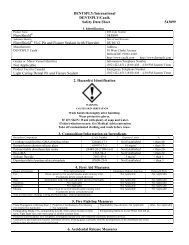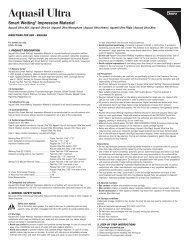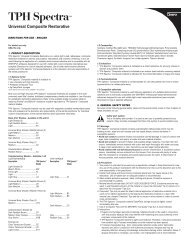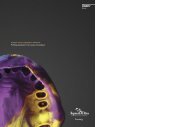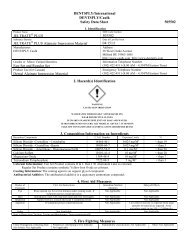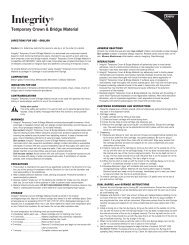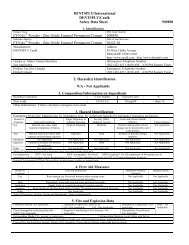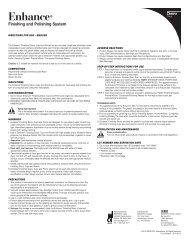Indirect and Direct Restorative Protocols - Caulk
Indirect and Direct Restorative Protocols - Caulk
Indirect and Direct Restorative Protocols - Caulk
You also want an ePaper? Increase the reach of your titles
YUMPU automatically turns print PDFs into web optimized ePapers that Google loves.
››Principles & Practices<br />
Aesthetic Finishing & Polishing:<br />
Techniques for<br />
Ceramic Restorations<br />
››Abstract:<br />
Contemporary ceramic materials<br />
enable dental professionals to<br />
instill natural aesthetics <strong>and</strong><br />
luster in the restorations of<br />
their patients. The long-term<br />
function <strong>and</strong> performance of<br />
these restorations depend on<br />
numerous factors that include<br />
marginal integrity <strong>and</strong> the<br />
creation of a proper finish <strong>and</strong><br />
polish. Development of an optimal<br />
surface reduces stain <strong>and</strong> plaque<br />
accumulation, minimizes wear,<br />
<strong>and</strong> enhances the appearance of<br />
the definitive restoration. This<br />
presentation exhibits a simplified<br />
protocol for finishing <strong>and</strong> polishing<br />
ceramic restorations.<br />
The increased patient dem<strong>and</strong><br />
for restorations that<br />
closely resemble natural<br />
dentition in aesthetics<br />
<strong>and</strong> function has contributed<br />
to the development of ceramic materials<br />
that provide the needed strength,<br />
durability, <strong>and</strong> beauty to meet those<br />
expectations. Although porcelain restorations<br />
such as CERCON® Zirconia<br />
<strong>and</strong> Finesse® (DENTSPLY Prosthetics,<br />
York, PA) possess intrinsic optical properties<br />
such as opalescence, fluorescence,<br />
<strong>and</strong> translucency that enable clinicians<br />
to achieve beautiful outcomes for their<br />
patients, minor marginal finishing is<br />
needed in virtually every indirect treatment<br />
to remove excess cement or during<br />
finalization of aesthetics or the occlusion<br />
(Figure 1). The use of a systematic finishing<br />
technique following cementation<br />
will improve a restoration’s long-term<br />
performance <strong>and</strong> maintenance of its<br />
marginal integrity.<br />
Once the restoration is seated, excess<br />
cement must be carefully removed, as<br />
any residual cement or marginal roughness<br />
will lead to plaque retention <strong>and</strong> the<br />
associated gingival inflammation. This<br />
will compromise not only the biological<br />
integration of the restoration with the gingival<br />
tissues but also the aesthetics, leading<br />
to chronic marginal inflammation<br />
<strong>and</strong> a potential for recurrent marginal<br />
decay. The restoration, therefore, must<br />
remain as biocompatible as possible (eg,<br />
particularly where in contact with soft<br />
tissues) to provide mechanical strength<br />
<strong>and</strong> aesthetics. Non-cutting, safe-end tips,<br />
which are featured in most tapered burs<br />
in the Midwest® Esthetic Finishing Bur<br />
system (DENTSPLY Professional, York,<br />
PA), enable the clinician to finish gingival<br />
margins while protecting the soft tissues<br />
throughout the procedure (Figure 2).<br />
Prior to selecting or using finishing<br />
instrumentation of any kind, the<br />
clinician should examine his or her<br />
Figure 1. Although ceramic restorations are delivered from the dental<br />
laboratory with a high luster <strong>and</strong> accuracy, minimal reduction may be<br />
necessary following cementation.<br />
Figure 2. Soft tissues can be effectively protected during marginal finishing<br />
with a Midwest ® Esthetic Finishing Bur (DENTSPLY Professional,<br />
York, PA), which features a non-cutting tip on the end of the bur.<br />
Inset: Cement can be removed marginally without lacerating the soft tissue.<br />
23



